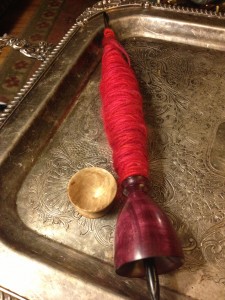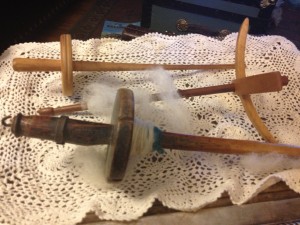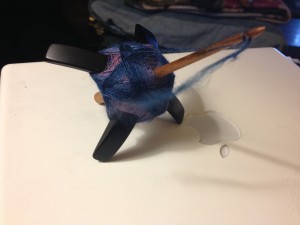This is going to be an odd post, as I’m commenting on a post from 2008. I was researching some things and ran across this post by Abby Franquemont: What’s the deal with those heavy spindles marketed for beginners? Now, let me start out by saying that I have great respect for Abby and that there are some points here that I do agree with.
But I remember it differently. I started spinning in the early 70s, in California. I’d recently moved out of the Bay Area to the San Joaquin valley. I wanted to learn to spin and had read books about it, but never really seen anyone doing it. And amongst the hippies of the day, it was a desirable skill. When you think of hippies in the late 60s/early 70s, you don’t think of a fringe group involved in fiber animals. It was a group of people intent on rediscovering how to make things with their own hands. I was lucky that I found a low whorl spindle made by a local guy. Yes it was heavier than I’d use today. Fortunately for me, it was pretty well balanced. I also picked up some fiber from the same place and I was on my way. But in those days, you made do with a spindle until you could afford a wheel. You were not a “real” spinner if you used a spindle, despite that long history of spindle spinners. If you want to see that attitude in action, you can check out that book by Allen Fannin (which I have and which does have several sections on spinning with a low whorl. To be fair, he treats handspindles with the same technical detail that he applies to great wheels.) Alden Amos has the attitude that you can’t be a production spinner if you use a spindle. I got my first wheel, a Pipy in the mid 70s.
Now, Louets were popular back then, because you could spin the thick yarns that were popular. And they really do make it easier to learn to draft, as they exert a pull on the fiber. But no one said that you should start out with a bobbin-led wheel and then some day get a double drive wheel after you’d learned to draft. You got the wheel you wanted and you learned how to spin on it. Many of those wheels were more fragile than the Louets, but people still got the wheel they wanted and learned how to care for it.
Why should spindles be any different? In fact, those heavy spindles were responsible for some people thinking that they couldn’t spin. And some of them learned that it wasn’t them, it was the spindle, when they got the spindle issue of Spin Off in 1995. And the books of the day put more focus on high whorls because everything, up to that time, had been focused on low whorl spindles. If I hadn’t found out about high whorl spindles, I would not be a spindle spinner today. In fact, the limits of my Pipy (which is designed to spin fine yarn) had really taken the joy out of spinning for me. I was into a different type of wool and wanted to make thicker yarns again. Rediscovering spindle spinning also rekindled my interest in spinning.
I am in favor of peopls using whatever spindle makes them happy. If they use spindles like this:

and they spin and enjoy it, then it doesn’t matter to me if it takes them awhile to learn how to use the tool. People are motivated by objects they admire. And what could be more exciting than a pretty spindle and some gorgeous fiber? You may not do the fiber or the spindle justice, but you will be motivatated to keep at it. I’ve taught beginning spinners to spin silk because that was what they fell in love with. And when you are in love with what you are doing, you just might be less likely to put your spindles away and spin on a wheel instead.
And I have a confession here: I have never liked Turkish spindles. I could not see any reason for them. I can do a centerpull ball on a nostepinne, so I don’t need a spindle that can do that. My exposure to Turkish spindles was the one in the picture above. Then I got this:
and I am completely obsessed with Jenkins Turkish spindles. Fortunately for me, he is a relatively local spindle maker and I’ll have a chance to pick up more at Oregon Flock and Fiber. We had that spindle with us in Woodcrafters yesterday, with no yarn on it. I wish you could have seen the very knowledgeable employee handle it. You could tell that he was impressed by the quality of the workmanship. (And I hovered over it like it was my first born! I wasn’t happy until I had it back in hand.)
We live in the glory days for spinners. We have wonderful tools and fiber. We spin strictly for pleasure. We have more in common with the French aristocracy, who did their silk spinning on elaborately turned spindles, than we do with those who used spindles for production. So feel free to buy that spindle that catches your eye and play to your heart’s content. If it doesn’t suit you, there are other choices out there. The spindle that doesn’t work for you, may be a dream spindle for someone else. And I will keep the boat anchors above, out of sentiment, but I don’t spin on them any more. I spin on the ones that make my heart sing.




Leave a Reply